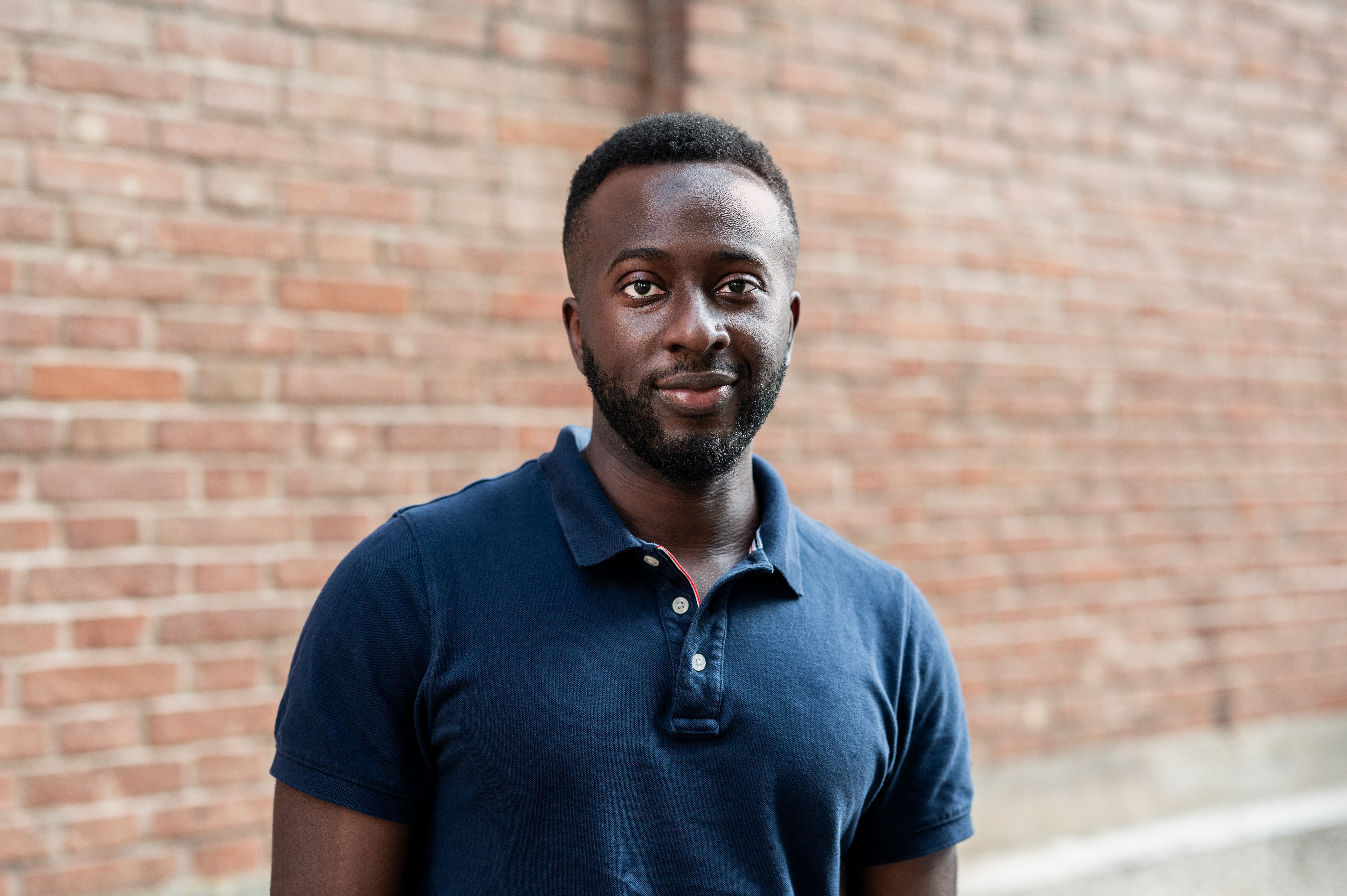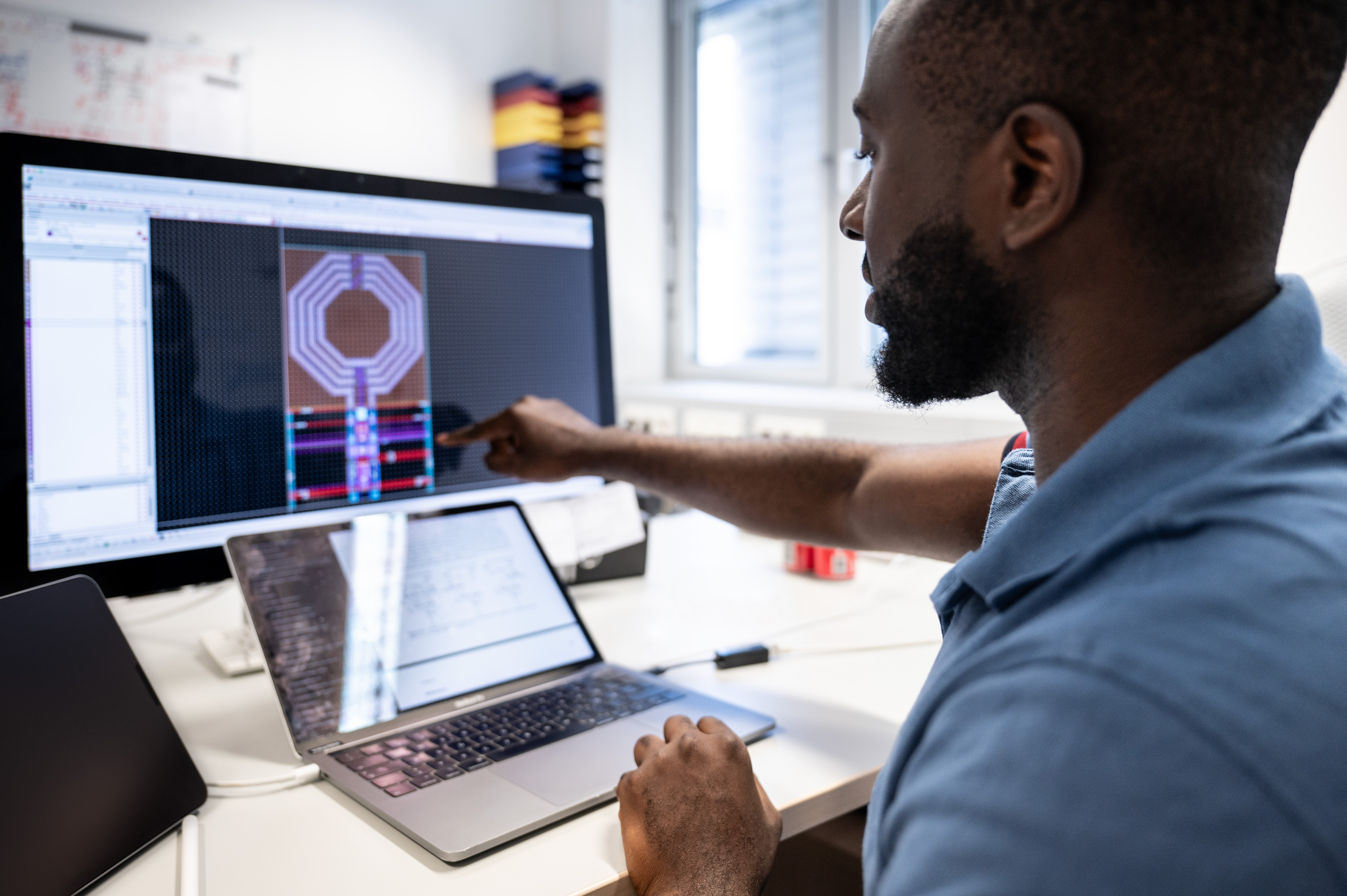"I build science-fiction computers like those from Star Trek"
Developing the foundation of quantum computers
As an electrical engineer, Johan Tsayem had to work his way into the world of qubits. Today, he designs quantum-control chips and uses them to develop the basis of future quantum computers.
By Veronika Früh
Colorful lines on a black background, which could also come from a video game of the 80s, flicker across Johan Tsayem's screen. "Anyone who has enjoyed playing Tetris will not feel foreign in this layout," he immediately draws a similar comparison. The 30-year-old is research assistant at the Fraunhofer Institute for Integrated Circuits (IIS) in Erlangen and designs quantum-control chips. The black background on his screen represents a silicon plate on which he places various components.
The quantum-control chips Johan is developing are, in a sense, part of the foundation of quantum computers: "At the level below us, it's really just the qubit chips. We are the people who build the control," he explains. The interdisciplinary exchange with MQV colleagues at the review meetings helped him to better understand the entire system, even if different worlds collided there for him: "What the software developers do, for example, is a great mystery to me. But I think it's the same for them the other way around." All the better to exchange ideas at regular meetings. "It's always exciting to learn what the other groups are working on. It gets crazier and crazier."
New paths in quantum electronics
The fact that Johan designs components for quantum computers, of all things, was more a matter of chance. He studied electrical engineering and information technology with a focus on microelectronics at Friedrich-Alexander-Universität Erlangen-Nürnberg. Along the way, he has worked as a student assistant at Fraunhofer IIS since 2017, where he also wrote his master's thesis and joined as a research assistant after graduation. "The topic of quantum computing came to me as part of a project," he says, recounting initial difficulties: "At the very beginning, there was total disillusionment." As an electrical engineer, it wasn't easy to get started in quantum mechanics. First, he had to find an approach to the complex topic for himself. "I don't have to understand everything, of course, but I had to at least understand what was relevant to my work," Johan says with a laugh.
The difference between this and his previous projects in classical microelectronics, he says, is that there is much less research in quantum electronics: "You do a bit of research in the dark, you don't know what's going to come out." Challenging and exciting at the same time, Johan finds, because it gives him the opportunity to have a real impact with his research. "I call it a bit of pioneering work," he says, "our results are really relevant to everyone else who is pushing research after us."
From Cameroon to Bavaria
However, Johan's own enjoyment of research in an engineering science crystallized only late in life. He actually wanted to study economics after graduating from high school, but the economic crisis got in the way: "My brother said that's the stupidest thing you can do now," he laughs. So he used his talent in mathematics and decided on electrical engineering. Originally from Cameroon, he first made a nine-month stopover in Clausthal-Zellerfeld in Lower Saxony after graduating from high school to learn German. With the certificate in his pocket, he was then able to begin his studies in Erlangen. Johan wanted to move to Bavaria because his uncle lives in Munich – but then not in the immediate vicinity: "Family, you know..." he says and laughs.
When Johan has to explain to family and friends who have no connection to quantum technologies what he is working on, he likes to refer to science-fiction movies: "I say the cool computers that appear in them are exactly the ones I build." And from Star Trek, many are familiar with quantum computers. "Of course, it's more complex than that," he admits, "but I want them to have some understanding of it."

Johan Tsayem, 30
Position
Research assistant
Institute
Fraunhofer Institute for Integrated Circuits (IIS)
SHARE
Degree
Electrical engineering and information technology
Johan develops controller chips for quantum computers and thus works on the foundation of the technology. With his chips, Application Specific Integrated Circuits (ASICs), which he designs for specific applications, individual qubits can be controlled.

Chip design as a creative process
When Johan designs a chip, he works with software that helps him place components on a graphical interface. "Different transistors, resistors, capacitors, inductors, everything you can imagine," he explains, pointing to colorful lines and shapes that he can move by mouse click on the black surface that represents the silicon. On the screen, he first assembles a circuit visually to better be able to picture it. Then he can simulate the behavior and verify that it has the desired properties. "Once you're satisfied with the schematic and the initial simulation, it's time to move over to the layout," he explains, opening another window on his screen. "Here you see the same circuits, but this is physical. This is what the chip really looks like in the end." The layout is the information that is then transferred to a wafer – a round disc about a millimeter thick, usually made of silicon – during manufacturing.
But before this happens, Johan does a so-called parasitic extraction. With this, he tries to find unwanted physical effects that are not related to the desired function of the circuit, but can occur due to the realization. "I can't calculate that beforehand; things come up that I didn't have in mind," he explains. If the result is worse than his expectations, more iterations are needed until the circuit is optimized. The finished layout is then sent to a semiconductor foundry to manufacture the chip.
Although the finished chip must meet specific, predefined requirements, getting there is a very creative process, Johan describes: "How we achieve the goal is up to us, and how the circuit ends up meeting the desired requirements varies from design to design. A colleague may find a completely different way for the same problem, but as long as it works, of course all solutions are valid." One design might need less power, but have other drawbacks. The more creative you are yourself, the more new things you can try. "That's just what I like so much about research, that you can just try a lot of things. Especially with the project I'm currently working on, I've been able to do a lot of that," the scientist says happily. But at the moment, patience is called for, because the layout is currently being manufactured. Johan and his team are now waiting for the wafer to be manufactured, sawed into small chips and these assembled into a test board that they can connect and test in their lab.
"We don't know yet whether the chip will work in the end, but I think I have a pretty good chance," Johan says. He is particularly proud of this current project because it has shown him that he can get far on his own. "Especially as a beginner, people are always looking over your shoulder, but here I was able to go through the whole process on my own for once. If you have problems, you can always approach the others, of course, but ultimately the work requires a lot of independence, and I'm glad that I can also develop a chip like this myself from A to Z," he says, visibly pleased.
Finding solutions in his sleep
When he's in the flow, the 30-year-old likes to sit in front of the computer until late at night: "I'm particularly productive around midnight, and it usually stretches until two in the morning." In the morning, he likes to go to the gym. However, should things not go so smoothly, his days get longer and his nights even shorter. "I don't give in on that. If I can't find a solution, I can't sleep well. Something just has to come out," he stresses. A brainstorming session can go on until four o'clock in the morning - and doesn't stop when he does fall asleep: "Sometimes I wake up at six o'clock and have my solution. Of course, he then has to put it down on paper right away. If the solutions don't come in his sleep, Johan can always rely on the exchange with colleagues.
By now he himself is also the one who can look over the shoulders of others. Currently, he is supervising his first master's thesis. For him, this is a good opportunity to go through the basics again and deepen his own understanding. He really enjoys the supervision and learns a lot. And he feels he's doing something good: "There are supervisors of this sort and that sort, I think everyone has experienced that." Now that he has this role himself, he tries to assist the master's students as best he can.
For Johan himself, his own doctorate is coming up soon – presumably. He hasn't quite decided yet, but if he completes his project successfully now, he can very well imagine it.
Published 27 October 2023; Interview 22 August 2023